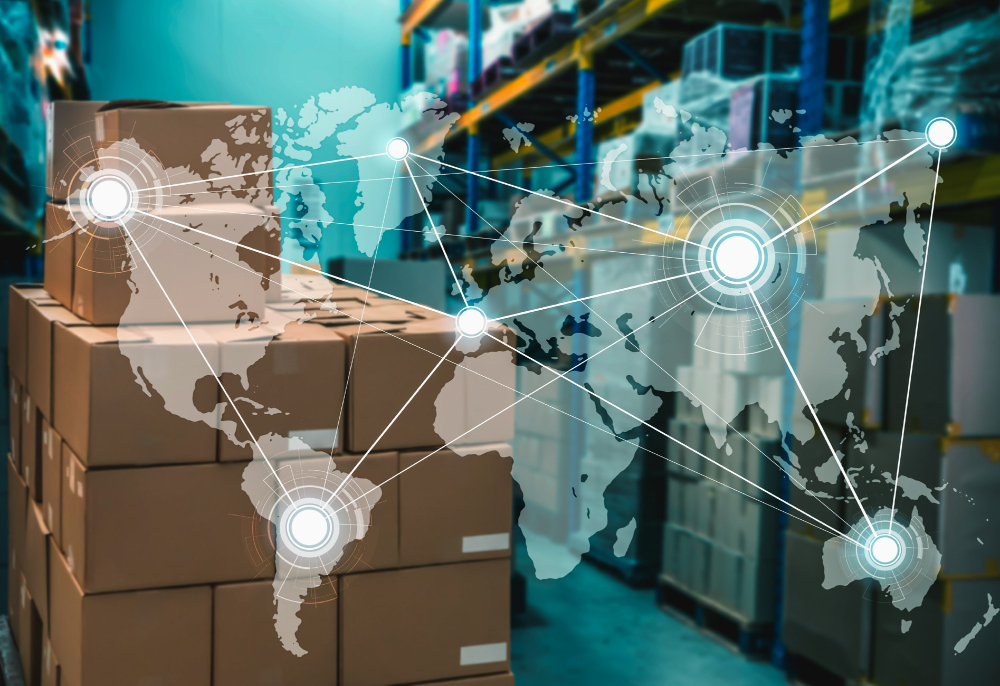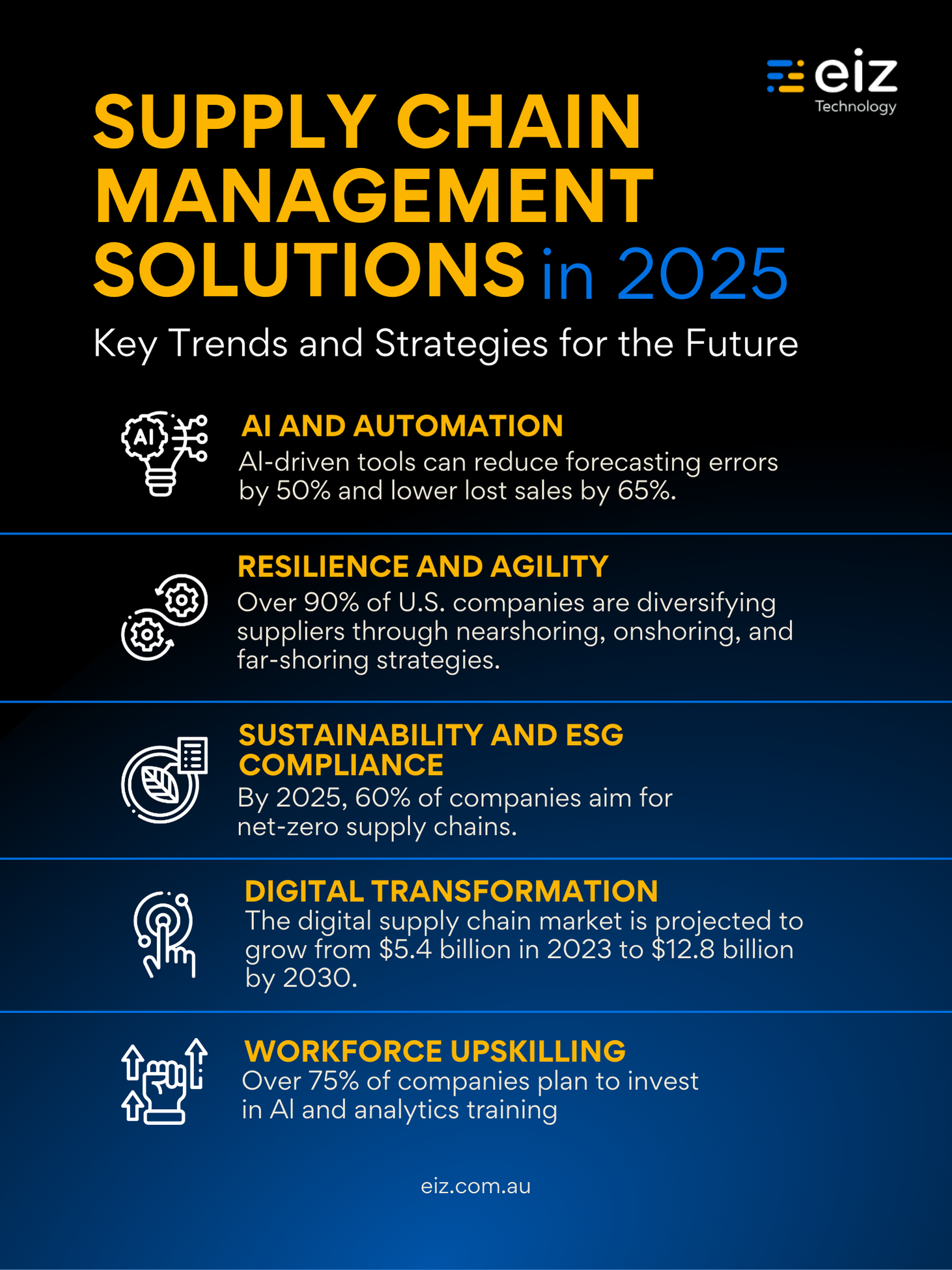The Complete Guide to Supply Chain Management Solutions in 2025
02 May 2025
|by josh@localthreads.com.au

Supply chain management (SCM) is undergoing a seismic shift as businesses brace for the challenges and opportunities of 2025. From artificial intelligence (AI) revolutionizing logistics to geopolitical tensions reshaping sourcing strategies, companies must adapt to stay competitive. This guide explores the technologies, trends, and strategies defining SCM in 2025, backed by key statistics and insights from industry leaders.
Key Trends Shaping Supply Chain Management in 2025
1. AI and Automation: The Backbone of Modern Supply Chains
Artificial intelligence is no longer a futuristic concept-it’s a critical tool for optimizing logistics, demand forecasting, and risk management. According to Supply Chain Insights, AI-driven tools can reduce forecasting errors by 50% and lower lost sales by 65%. Companies like Colgate-Palmolive are already leveraging AI to enhance production efficiency and demand planning, proving its practicality at scale.
Kevin O’Marah, Co-Founder of Zero100, emphasizes the transformative potential of AI:
“GenAI isn’t just a job killer; it’s a job enhancer. Supply chain leaders must design smarter roles that merge human intuition with machine precision.”
Automation is also accelerating, with robotic process automation (RPA) streamlining tasks like order processing and warehouse operations. By 2030, the AI in supply chain market is projected to reach $41.23 billion, driven by the need for real-time decision-making.
2. Building Resilient and Agile Supply Chains
Geopolitical tensions, climate disruptions, and pandemics have made resilience a top priority. Over 90% of U.S. companies are diversifying suppliers through nearshoring, onshoring, and far-shoring strategies, as noted in a U.S. Chamber of Commerce survey. However, managing a global supplier network requires advanced tools like supplier relationship management (SRM) software to balance complexity and cost.
Yossi Sheffi, MIT Professor and supply chain expert, warns:
“Any company that did not invest in supply chain disruptions is not around.”
The 2025 Supply Chain Stability Index highlights improved stability, but bottlenecks like U.S.-Mexico border delays persist. To mitigate risks, 66% of executives prioritize cybersecurity and real-time monitoring, according to KPMG.
3. Sustainability and ESG Compliance
Environmental, Social, and Governance (ESG) criteria are reshaping supplier selection. Legislation like the EU’s Corporate Sustainability Due Diligence Directive (CSDDD) mandates ethical sourcing, pushing 75% of businesses to audit suppliers for carbon emissions and labor practices (QIMA Survey).
Lora Cecere, Founder of Supply Chain Insights, notes:
“Sustainability isn’t a buzzword-it’s a operational imperative. Digital tools are the bridge between profit and planet.”
The push for transparency is evident in industries like fashion, where blockchain tracks materials from farm to store. By 2025, 60% of companies aim for net-zero supply chains, driven by consumer demand and regulatory pressures.
4. Digital Transformation: From Legacy Systems to Cloud Analytics
Cloud-based analytics are enabling end-to-end visibility, with the digital supply chain market projected to grow from $5.4 billion in 2023 to $12.8 billion by 2030. IoT sensors and predictive analytics help companies like Amazon optimize routes and reduce fuel costs by 15%.
Martin Christopher, Cranfield School of Management Professor, famously stated:
“Supply chains compete, not companies.”
Adopting digital twins-virtual replicas of physical networks-allows firms to simulate disruptions and test mitigation strategies. However, 62% of organizations still struggle with limited visibility, per WarehouseWiz.
5. Workforce Upskilling and Labor Shortages
Despite automation, skilled labor remains scarce. Over 75% of companies plan to invest in AI and analytics training, according to Gartner. Generative AI is bridging knowledge gaps: one materials company improved operational efficiency by 15% by using AI chatbots to guide workers through complex tasks (MHI Report).
Hau Lee, Stanford Professor and “bullwhip effect” pioneer, advises:
“Don’t overreact to demand fluctuations. Use data to align production with real needs, not panic.”
6. Nearshoring and Reshoring: Reducing Geopolitical Risks
Tariffs and trade wars are accelerating nearshoring, with 50% of U.S. firms sourcing from Mexico instead of China (QIMA Survey). While this reduces lead times, it requires reconfiguring logistics networks. The Digital Supply Chain Market growth reflects the need for agile tools to manage localized production.
7. Customer-Centric Supply Chains
Today’s consumers demand transparency and speed. Farm-to-table restaurants and eco-conscious brands use IoT to share real-time data on sourcing. AI personalizes experiences, such as in-stock alerts and tailored delivery options.
8. Advanced Analytics and IoT: The Data Revolution
Real-time tracking via IoT sensors minimizes delays, while predictive analytics optimizes inventory. The retail supply chain management market is expected to hit $58.87 billion by 2030, fueled by e-commerce growth.

Challenges in Modern Supply Chains
- Cost Pressures: Inflation and tariffs strain margins, forcing leaders to analyze cost-to-serve at granular levels (KPMG).
- Cyber Threats: 67% of executives cite cybersecurity as a top concern (Global Trade Magazine).
- Talent Gaps: 30% of firms struggle to hire AI-literate staff (Supply Chain Insights).
Innovative Solutions for 2025
- AI-Powered Demand Forecasting: Reduce overstocking by 50% with machine learning.
- Blockchain for Transparency: Track ethical sourcing and combat counterfeit goods.
- Autonomous Vehicles: Slash last-mile delivery costs by 20% using drones and self-driving trucks.
The Future of Supply Chain Management
By 2025, supply chains will be defined by resilience, sustainability, and hyper-automation. Companies that embrace AI, upskill workforces, and prioritize ESG will lead their industries. As Yossi Sheffi warns, “The true magic of modern supply chains is in how much they can do with limited time and restricted budgets.”